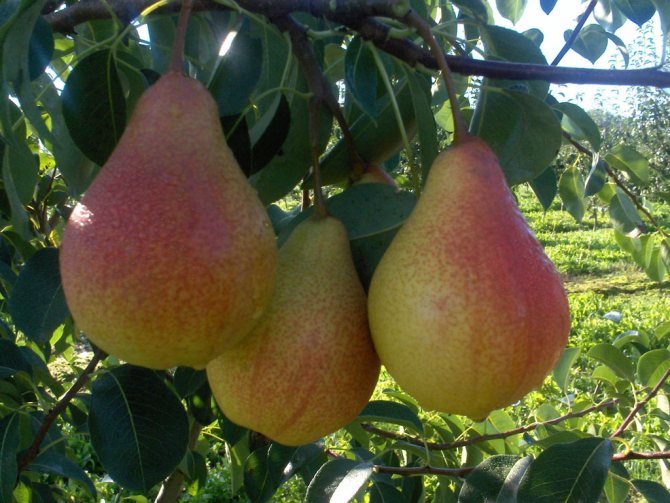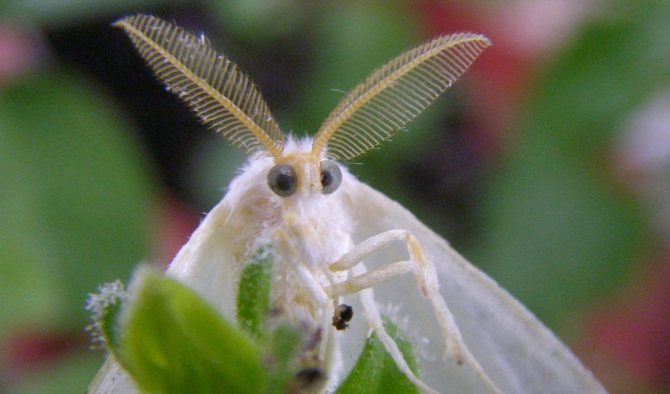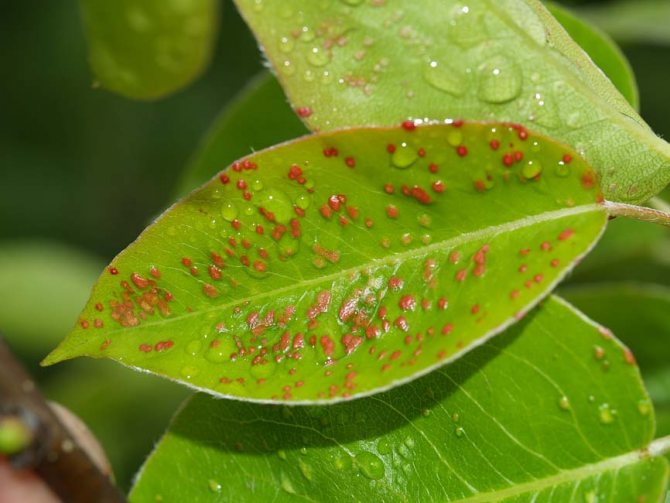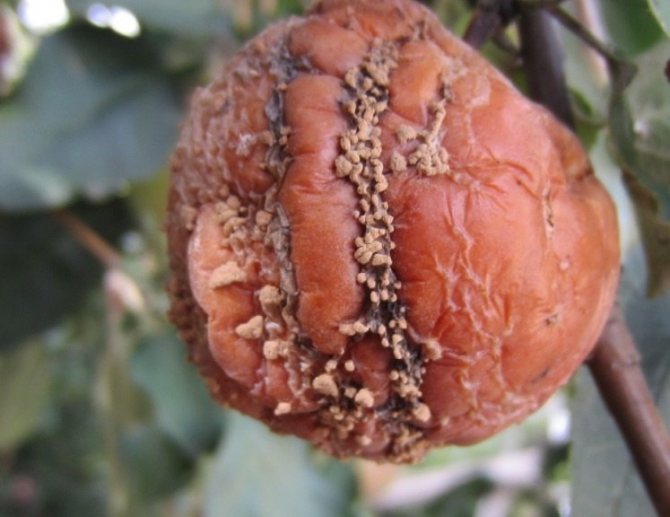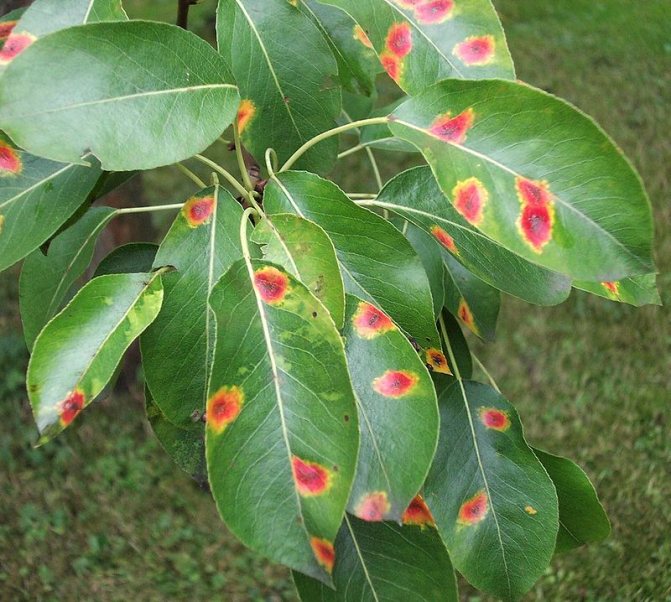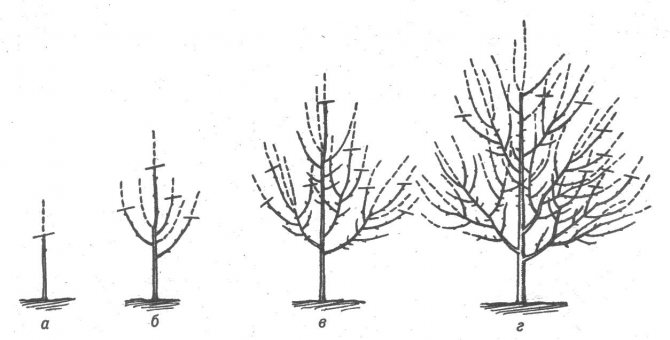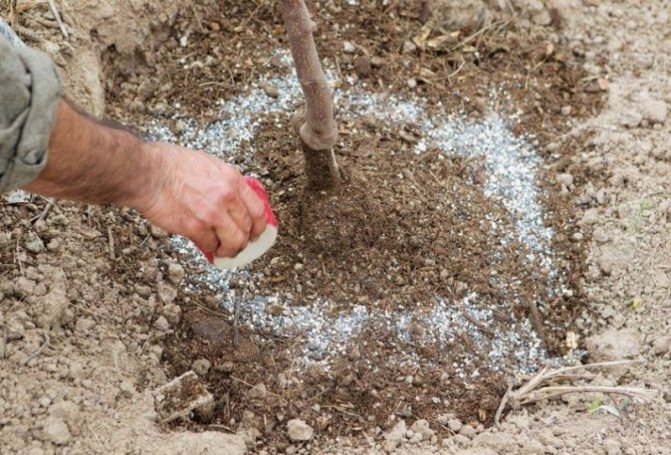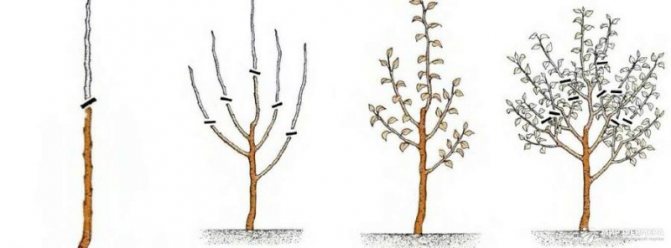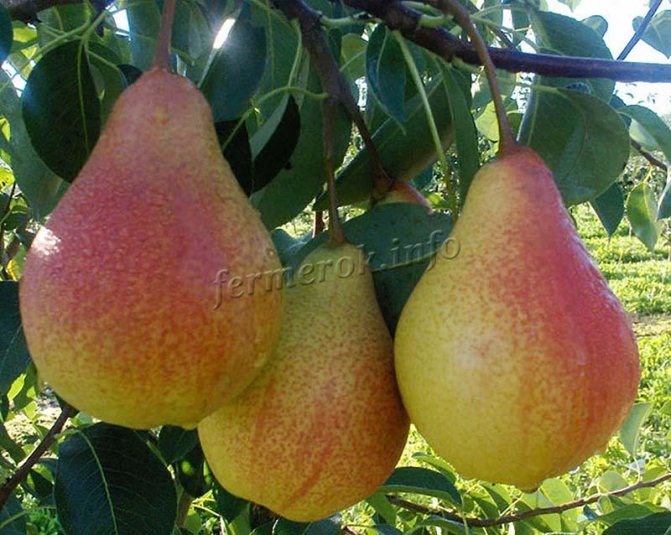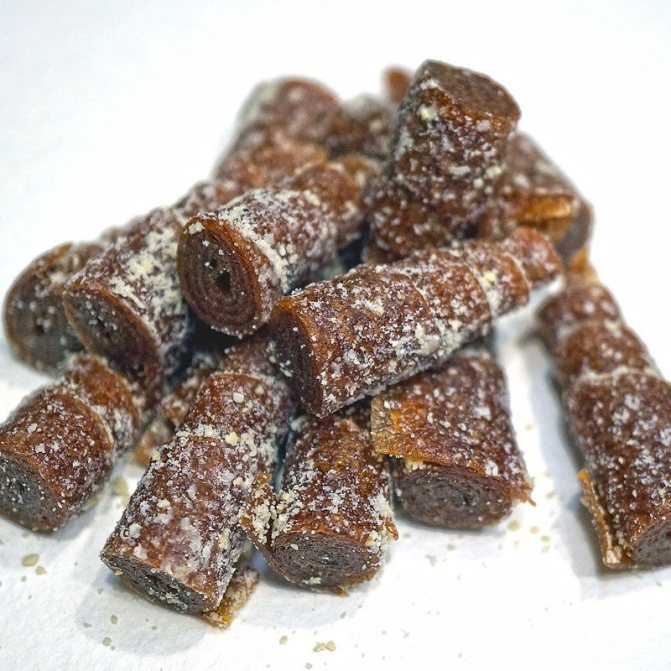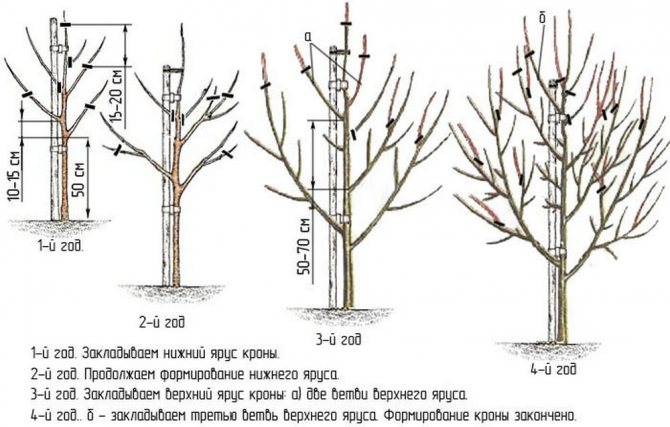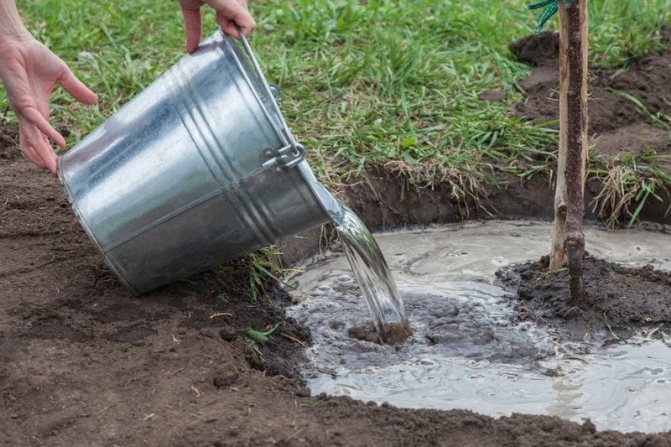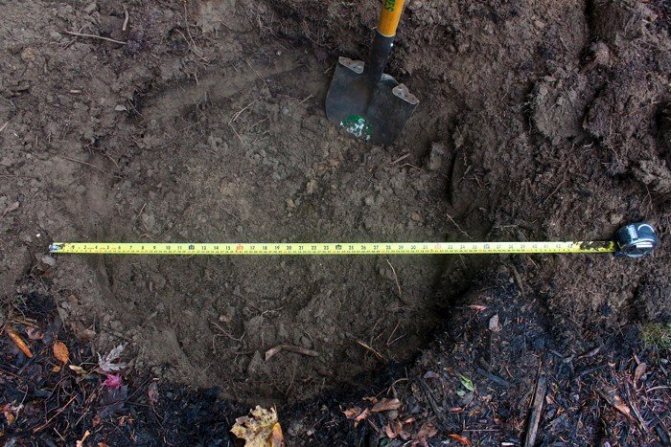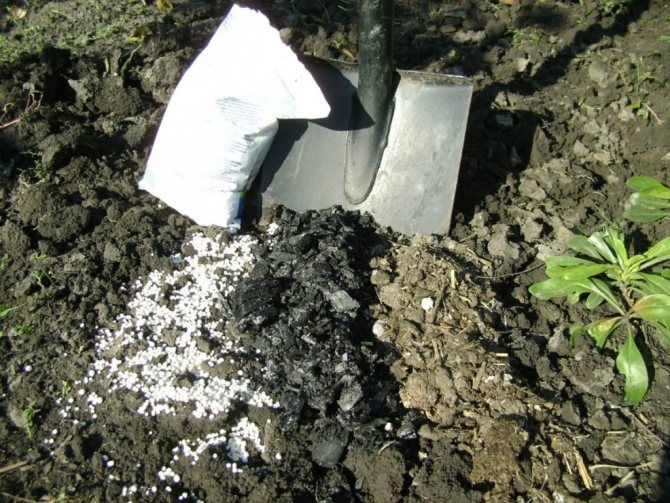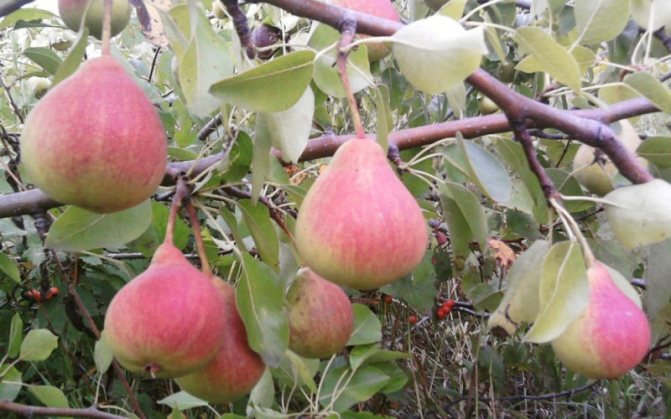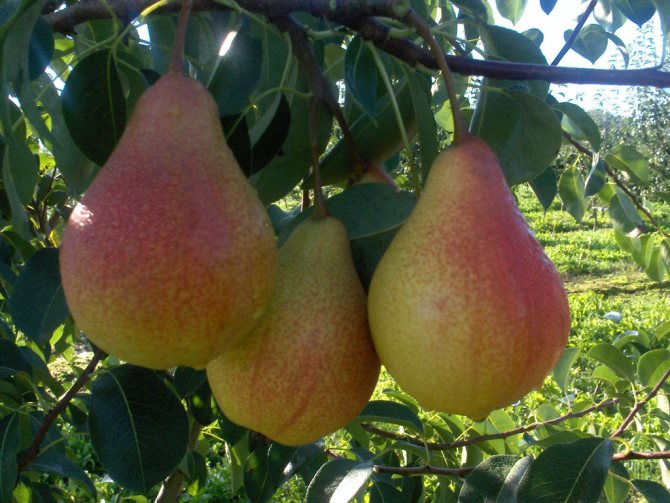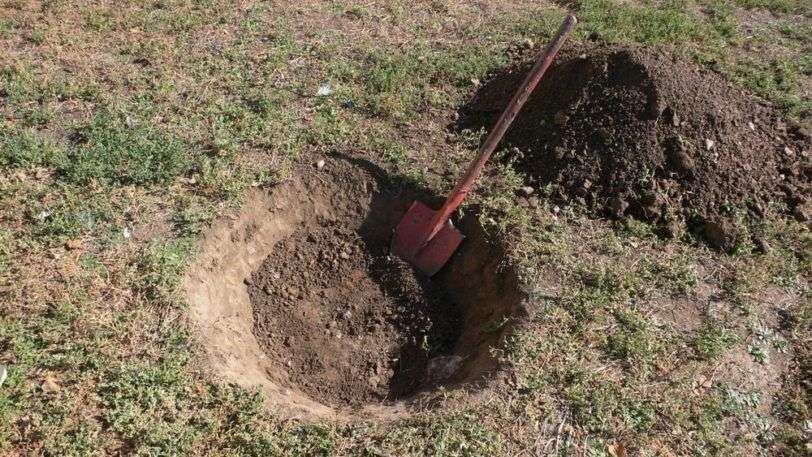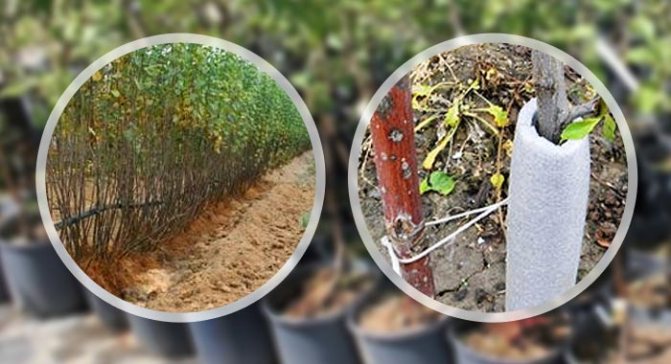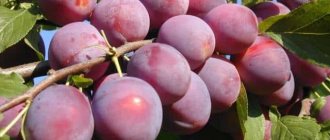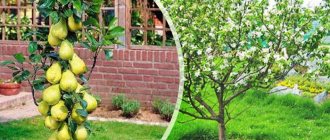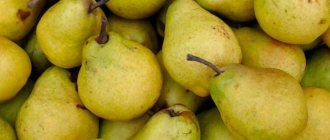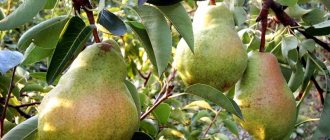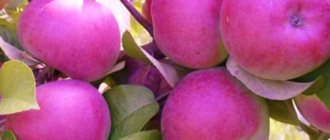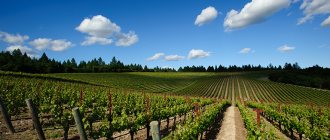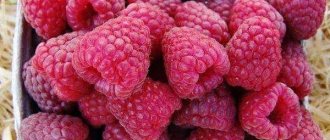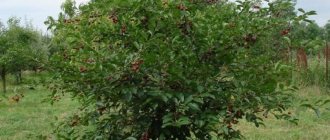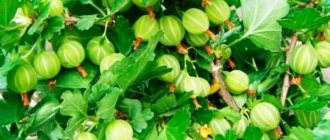In our article "Marble pear" you will learn everything about planting and caring for this tree in order to get a big harvest.

The fruits of this pear ripen in early autumn. The variety appeared at the experimental station of Rossoshanskiy gardening by crossing:
- Bere winter - Michurina.
- Forest beauty.
In 1965, it was entered into the state register of the Russian Federation, and it was zoned for the Central regions of Russia, as well as for the Volgo-Vyatka and Nizhnevolzhsky regions.
Description and characteristics of the variety with photo
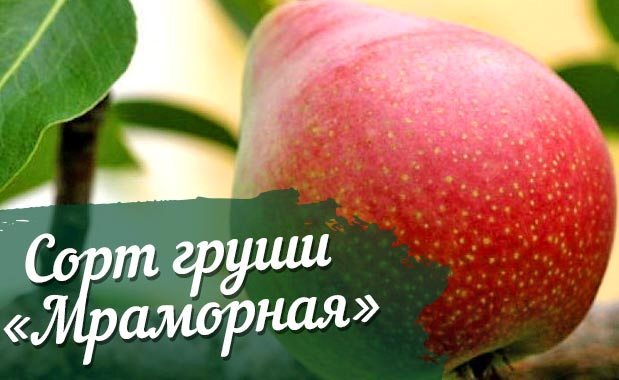

Wide pyramidal trees are endowed with medium vigor. If not cared for properly, they can reach a height of 6 meters. But most often trees are kept under control no more than 4 meters high.
The bark of skeletal branches and stem is greenish-gray. The tree's not very strong shoot-growing ability forms a crown of medium density, which is supported by powerful branches. The reddish-brown shoots are densely packed with light, imperceptible small lentils.
Shiny medium-sized leaves have a round base, almost even smooth plates are serrated along the edges.
The inflorescence consists of a large number of rather small (3 cm) flowers and resembles an opened umbrella. If the period of flowering of the Marble pear is compared with others, then it comes a little earlier.
Fruiting occurs on relatively young branches, 2-4 years old, provided that the tree itself is 6 years old after budding. Rounded-conical regular shape fruits reach about 170 gr. Their color is mainly yellow-green, with a cover of blurry marble blush. Fruits with a small number of seeds and coarse-grained tender creamy pulp. The pears are fragrant, juicy and sweet.
Ripening occurs at the end of summer and lasts about 3 weeks (in terms of timing - early autumn variety). The fruits do not differ in keeping quality - after a couple of months they begin to deteriorate en masse. But the transportability of the Marble variety is good. The strong skin on the fruits protects them from minor damage during transportation.
Productivity in different regions is noted in the range of 160-240 kg per crop. It depends on the level of humidity: during the dry period, the pear sheds part of the fruit.
The marble variety does not differ in excellent winter hardiness, since it has been bred for the southern expanses. Gardeners have repeatedly noted the low winter hardiness of flower buds.
Characteristics
The marble pear usually begins to bear fruit in the sixth to seventh year after budding and is characterized by high yield... Its fruits usually ripen in early September, and the consumption period lasts about three to four weeks. The removed fruits can be stored for sixty to seventy days. They have a high level of transportability and good marketability.
Factors that can reduce yields are dry weather and strong gusts of wind, which can cause pears to fall off. Marble pear is characterized by medium frost resistance.
She tolerates especially poorly the May frosts, during which not only her flowers, but also the trees themselves can die.
Rogneda, Duchess, Sverdlovchanka, Fairy, Lel and Chizhovskaya demonstrate good frost resistance.
One of the advantages of the marble pear is its resistance to scab, powdery mildew and fruit rot. As pollinators for Marble pear, pear varieties such as Cathedral, Severyanka, Oryol summer and Oryol beauty.
Advantages and disadvantages


There are no ideal plants to be liked by everyone, without exception, to meet all the requirements and parameters. So the Marble Pear is no exception, having its excellent performance and negative points.
Benefits:
- Large fruits are very juicy, sweet;
- Transportability is good;
- High yield rate;
- The variety is resistant to diseases such as fruit rot, powdery mildew, scab;
- The high vitality of the tree allows it to quickly recover from mechanical and climatic damage.
Interesting! The marble pear is included in the diabetic diet.
Disadvantages:
- Short-term storage of fruits;
- In a rainy summer, there is a risk of scab disease;
- The dry period significantly reduces the yield;
- Fruiting occurs only after the tree reaches 6 years of age;
- Low winter hardiness;
- The variety has a special sensitivity to the frost in May: all flowers, sometimes the tree, die;
- It is necessary to thin out the crown regularly for a marble pear.
Diseases and pests of pear
The resistance of the Marble Pear to the main diseases characteristic of other varieties of such a fruit tree is quite high. Also, this culture is practically not affected by pests.
The only disease that this pear can be affected by is powdery mildew. You can fight this disease by treating the aerial part of the tree with a solution of fungicides.
Gardeners reviews
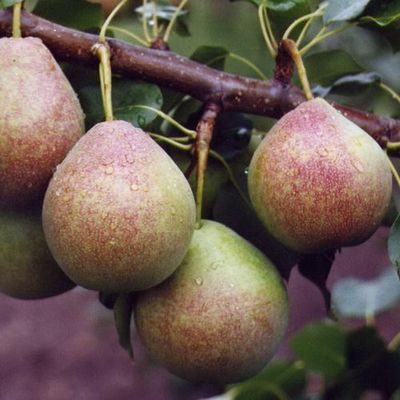

The opinions of summer residents regarding the Marble pear variety vary greatly, depending on the cultivation zone. Gardeners of the middle lane are not very happy with the pear, but those who live to the south grow it more willingly.
Mikhail, Yeysk
The full ripeness of the fruits begins in October, but even before this time, ripe and not autumn pears begin to crumble from the tree. And if at such a moment a fresh, gusty breeze arrives in time, then the pears are sprinkled like peas. The variety does not shine with a shelf life anyway, and lined fruits generally deteriorate quickly. We have to deal with emergency procurement and processing. For me, this variety is more for extreme sports.
Valery, Maykop
For novice summer residents, Marble is an excellent choice. She looks like a forest beauty, and they are often confused. For me - Marble is better.
And the crown is less common, the fruits are sweeter, ripens faster. I do not experience any particular difficulties in leaving. The harvest is always large, the surplus is readily bought up.
Lydia, Goryachy Klyuch
We have been growing this beauty for many years, but the yield is still off scale. We have never fertilized it, so we bought a dacha, trees are growing and growing. They only watered, but sawed off the dried branches. Here is only one drawback of her - in order to close or save the pears, they have to be picked by hand. As it falls from a height to the ground, so does porridge. Only the goat rejoices at this.
Nikita, Najdorf
Tempted by such a beautifully painted variety, from a great mind, he took and planted a dozen trees. Now every year we dry a mountain of fruits, roll them up, cook, make wine, distribute. And all the same, because of the terrible keeping quality, you have to throw out the pears in buckets. Only the cattle helps out, but you won't give her much either. For the last 5 years, I began to mercilessly cut trees. I leave 3 branches each, and then I limit the height. The tree is strong, survives, even bears fruit. I would have known - from the first year I shortened it and did not launch it.
Description of pear Marble
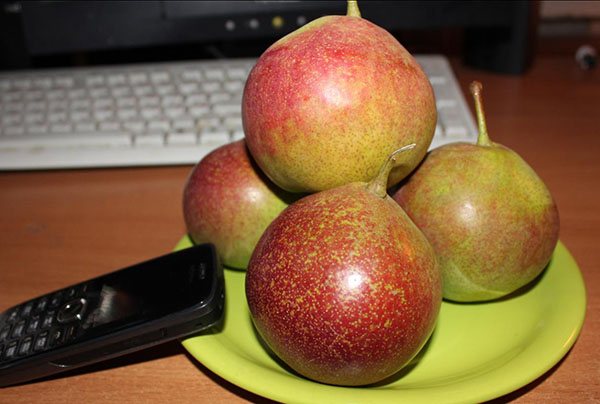

This species appeared as a result of the selection of the varieties Lesnaya Krasavitsa and Bere Zimnyaya Michurina. The pear owes its name to the scarlet spots on the surface of the fruit.When grown in favorable areas, it ripens in early autumn. The most favorable regions for growing, according to agronomists, is the middle strip of the European part of our country.
Planting in colder climates requires special care, as severe frosts can be detrimental to the marble pear. In this case, the seedlings should have a formed root system, and the planting place should be located in a sunny corner of the garden.
A characteristic feature of the tree is a straight trunk, up to 4 m high, vertically arranged branches and a pyramidal crown with elliptical foliage. Depending on the age of the culture, the bark can change color: red-brown in young shoots and greenish-gray in old ones. The flowering period begins in the second half of May.
The fruits ripen in late summer or early autumn and are distinguished by an unusual color: red vague spots on a yellow background resemble marble.
The yield of one tree per season is about 50 kg, and the weight of one fruit is on average 200 grams. The pulp is juicy and sweet. The characteristic of the Marble pear variety endows it with high commercial qualities and a long shelf life.
Harvesting and storage
The fruiting time of the described variety starts in the second decade of August and lasts until the first decade of September, sometimes stretching to early October, when the fruits reach full ripeness. Experts recommend picking pears on a warm and dry day, plucking them from the tree along with the stalk.
Pears are stored in boxes or wicker baskets, alternating with sawdust or torn paper, in a dry and dark room at a temperature of 0 ... + 3 ° С. Fruits in these conditions retain their condition for 60–70 days.
Read more about the features of storing pears for the winter at home.
The Marble pear variety, having a solid cultivation experience in various regions and even countries, has by no means lost its position under the onslaught of many modern varieties. The extraordinary taste of the variety, coupled with high yields, allows Mramornaya to occupy an honorable place today both in farm gardens and in summer cottages and household plots.
Landing technology
To grow a healthy and fruitful tree, you must carefully approach each stage and follow the recommendations of experienced gardeners.
Sapling selection


In order for the seedling to quickly take root and not get sick, it is worth purchasing it in specialized nurseries, taking into account a number of factors:
- The age of the planting material should not exceed 2 years.
- The bark should be free of roughness and defects.
- A two-year-old plant has 3-4 side branches.
- Root system intact, about 30 cm long.
For additional protection of the root, it is better to give preference to a tree with an earthen ball.
Landing site


For the optimal development of the Marble pear, a well-lit area without a walking wind and with a high-quality drainage system (hill) is required. If possible, this should be the southern section of the garden, a few meters from the fence or wall. The culture loves loamy or loose soil with an admixture of peat, compost or humus.
If planted in a damp place or if there is no good drainage, the tree will die.
Planting is carried out in late spring or early autumn. When planting several seedlings, it is necessary to place them no closer than 4 m from each other.
We recommend to read: Technical characteristics of Chinese-made Weima cultivators. Features of service for diesel and gasoline models. Operating instructions for cultivators
The work is performed in a specific sequence:
- A couple of weeks before planting, dig a hole 0.8 m deep and 0.6 m wide.
- Mix organic and mineral fertilizers with fertile soil, then fill half of the hole with it;
- Drive a peg 1.5 m high and 5 cm in diameter into the center of the pit as a support for the seedling;
- Conduct a visual inspection of the planting material for damage. Cut off the affected areas with pruning shears.
- Place the tree in the center of the recess, spread the roots and cover with soil so that the root collar is 5 cm above the ground.
- Tamp the soil and tie the seedling to the peg.
- Drizzle at the rate of 20-30 liters under one root.
- Mulch the planting site with foliage, sawdust or straw.
Read also: Pear varieties for Central Russia (summer, autumn, winter) with photos and descriptions
The pollinators of the Marble pear are the varieties Orlovskaya Letnaya, Kafedralnaya, Severyanka or others that bloom in parallel with it. It is necessary that they are located in the area nearby.
Reproduction methods
There are two ways to reproduce pear trees:
- seminal;
- vegetative.
The vegetative method includes the ability to obtain seed by cuttings or using green cuttings. A convenient way is to purchase seedlings in specialized stores. Planting material is carefully selected, plants with underdeveloped roots and lack of buds on the trunk do not acquire. Preference should be given to seedlings with a closed root system.
Care rules
For healthy growth and abundant fruiting, high-quality and timely care is needed, which consists in seasonal pruning, watering, fertilization, treatment from insects and diseases.


If the fruits began to crumble, then the tree does not have enough moisture. To avoid this, it is necessary to monitor the condition of the soil under the pear, avoiding drying out during the entire growing season.
For proper watering, grooves should be dug around the trunk 10 cm deep, and already in them water should be poured at the rate of 25 liters under one root, increasing the rate to 50 liters in dry times.
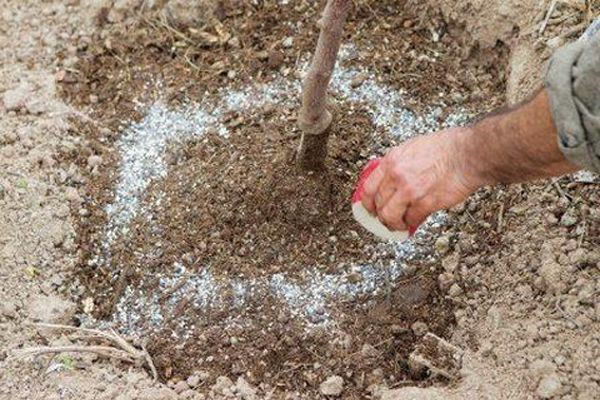

The introduction of nitrogen-containing fertilizing is carried out with the beginning of flowering. For these purposes, 200 g of urea diluted in a bucket of water is suitable.
At the end of fruiting, you need to dig up the ground around the tree and apply organic fertilizers: compost (5 kg), manure (2 kg) or bird droppings (1 kg).
Spraying with a 1% urea solution has a beneficial effect on growth, which is carried out 1.5 weeks after the end of flowering, and then, after another 15 days.
It is possible to identify the lack of certain trace elements when examining the seedling. Lack of nitrogen affects the color of the foliage, and it acquires a pale green color. With a lack of calcium, the foliage becomes stained, and a deficiency of potassium will lead to a brown tint.


High-quality planting and care with a marble pear cannot do without pruning. Before the start of the season, work is done in early spring, and at the end - in the fall, before the onset of frost. The procedure is performed annually:
- For young seedlings under 2 years old, only dry or damaged branches should be cut.
- In the third year, only the trunk and 3 healthy branches should remain intact. Cut the rest by 70%.
- After a year, cut the main branch into 8 buds. Shorten the rest by 30% of the total length.
- In subsequent years, old, dry, diseased and frozen shoots should be pruned.
For work, it is necessary to use sharp tools: pruning shears, a saw or scissors, processing the cuts with garden pitch.
You can enjoy the juicy and tasty fruits of the marble pear from the sixth year of cultivation. Due to the properties of the variety, fruits will retain their qualities for a month after harvest.
Defeat of marble pears by pests - video
How to care, pollinators
Further activities are not particularly difficult. The pear loves abundant watering, it is even capable of throwing off the ovaries in its absence.
At the same time, increased soil moisture is also undesirable, because the roots can rot. It is optimal to maintain a weekly watering frequency, about 2 - 3 buckets for each seedling.
Important points of care:
- In the spring, it is necessary to spray the tree with solutions from pests... For this, you can use urea, as well as special complexes. Damaged trees are sent to "quarantine" for further monitoring. The variety is relatively resistant to scab, but it is not well protected from other diseases.
- Top dressing in the first three years after planting is carried out once a season with organic fertilizers (usually in early spring)... Mineral complexes are not used, because when planting, the pear received everything it needs for growth.
- After three years, the feeding increases. The usual scheme involves the use of spring organic feeding, and in the fall after harvesting, a phosphorus-potassium complex can be added. This will ensure a good laying of fruit buds for the next year, but an overabundance of minerals will delay growth and may even destroy the plant.
- It is advisable to combine watering with loosening, because the pear is very susceptible to oxygen supply... It is necessary to loosen the soil shallowly, being careful not to damage the sensitive rhizomes.
- Harvesting is carried out gradually, as the pears ripen... It is advisable for these purposes to purchase a ladder - a stepladder to pick pears directly from the tree. If the fruit falls, it can be damaged, so they are used immediately. If pears are removed at the stage of technical ripeness, they can be stored in a cool room with sawdust or straw for up to three months.
- Pruning dry branches is carried out as needed. The cut sites are processed with garden varnish or beauty, in the spring the trunk needs whitewashing from pests and protection from sunlight.
But how the August dew pear is grown, and how this variety looks in the photo, you can see here.
The video shows how to care for a planted tree:
The fruits of this variety are distinguished not only by their attractive taste, but also by their good transportability. This will help you get additional benefits from such a crop, using it for sale.
"Marble" refers to well-pollinated varieties, but it is desirable to place it among the plantings of other species. This will significantly increase productivity, especially with the right choice of pollinator varieties.
It is also worth learning more about how to plant a honey pear correctly, and what you should pay attention to.
The following varieties are considered the best "neighbors" for marble pears:
- Tatiana is an autumn variety with excellent characteristics.


Pear variety Tatiana - Chizhovskaya is a fast-growing pear with high frost resistance.
- Lada is a frost-resistant variety with an early flowering period.
The "Marble" variety belongs to the classic selection of the well-known "Forest Beauty", so its popularity is simply incredible. A mid-season variety with resistance to frost and characteristic diseases, moreover, high-yielding and unpretentious. This is just a gardener's dream, because the pulp of the fruit has excellent taste characteristics, excellent keeping quality and transportability. Growing such a pear is not particularly difficult, and the main nuances of this case are discussed in the information in this article.
And here you can read information about reviews about the conference pear.
Description of the variety
This is a variety approved for cultivation in the Central (Bryansk region), Central Chernozem (Belgorod, Voronezh, Kursk regions), Nizhnevolzhsky (Volgograd region) regions.
Let's analyze the pear grade Marble its full characteristics. The tree is medium-sized, the height is from 3.5 to 4 m, the crown is medium-dense, pyramidal in shape.
The leaves are large, the surface is not pubescent, smooth, glossy. The shape of the leaves is oval, with small notches at the edges.
Pear flowers are numerous, small, up to 3 cm in diameter, whitish, turning into pink as it blooms. Early flowering. The pear needs a pollinator. Pollinators are other varieties of pears that bloom at the same time, for example, Orlovskaya, Severyanka, Moskvichka.The shoot-forming ability of the tree is low.
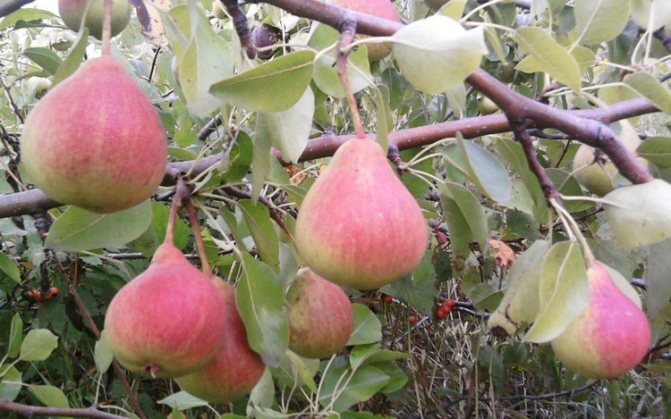

Fruits are medium in size, weighing 120-160 g. Pears have a characteristic conical shape. The color of the skin is green-yellow with a brown-red integumentary blur, similar to marble, due to which the name of the variety originated. Subcutaneous rusty spots are visible throughout the fetus. The peduncle is of medium length, thick, curved. The pulp is white or creamy, tender, juicy, melting, coarse-grained. The fruits have a high tasting score - 4.8 points out of 5.
Ripening period - late summer-early autumn.
Average winter hardiness - up to -25 ° С. In colder temperatures, shelter is required, especially in the trunk circle, protecting the root system with mulch. The part of the trunk, free of branches, is tied with covering materials.
Purpose - dessert variety.
Interesting. The culture is propagated by grafting. Pear trees on seed stock can bear fruit up to 100 years, grafted on quince - 35-40 years.
The beginning of fruiting after planting a seedling occurs at 6-7 years.
The variety is moderately resistant to scab; treatments should be done, for example, with copper sulfate. With a large lesion, they are treated with industrial fungicides up to several times per season, but no later than 3 weeks before harvesting.
Thanks to the thick skin, the fruits tolerate transportation well and are stored in a cool place.
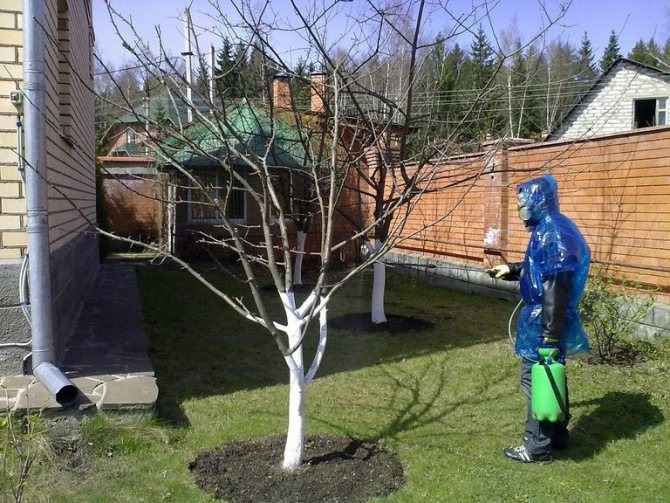

Processing pears with industrial fungicides
Agrotechnics
Pear is the most demanding culture for lighting. A place for growing pear trees should be chosen not only warm, protected from cold winds, but also sunny, spacious. Only with sufficient sunshine do the best varietal characteristics of the crop and its high yield appear. If the growing area is shaded, the tree will begin to stretch to the detriment of the strength of the crown, and the fruits will form only at the tops. When light comes from only one side, the crown will mix. Improper development of the crown, its asymmetry will lead to branch breakage, poor fruiting, and sometimes the death of the tree.
Read also: Useful tips for planting and caring for a pear in the spring in the open field
We recommend to read: Contents1 Challenger tractors - models and their characteristics 1.1 The range of Challenger tractors 1.2 Challenger MT685D tractor1.3 Challenger MT765C1.4 tractor Challenger MT8652 tractor Challenger tractors - their models ...
The most important light for photosynthesis and the formation of fruit buds is morning light, which comes from the eastern or southeastern side. In a row, trees are recommended to be placed from north to south so that their crown receives uniform illumination from all sides. The distance between individual pear trees is kept 4-5 m, from tall trees a pear is planted at a distance of 6 m.
Important! The close, several meters, occurrence of groundwater leads to rotting of the root system and is detrimental to any fruit trees.
One of the best places to plant pears and apple trees is on the slopes, but not in low wetlands. Soils suitable for cultivation must be fertile, the pear is demanding for watering.
With a lack of moisture, especially at a young age, few fruiting buds are formed on the trees, a strong shedding of color is possible. Dry air also reduces yields and impairs the palatability of the fruit. Water the pear preferably with warm water, for example, heated in the sun during the day, or arrange irrigation systems.
The high yielding Marble Pear variety may require the construction of supports to avoid branch breakage.
Planting a pear seedling
The root system of the pear has a weak ability to regenerate. A two-year-old pear seedling has overgrown roots; it can be difficult to dig them out without damage.To less traumatize the roots, it is recommended to choose a one-year seedling for planting. A one-year-old seedling is about 120 cm long, without branches, but may have several additional shoots. When choosing a planting material, you should pay attention to the vaccination site, which should be visible. The roots of a quality specimen should be moist, but not sticky, have one main root and several additional ones, about 40 cm long.
Important information! Healthy roots of a pear seedling are elastic, do not break, do not have growths and damage.
Saplings for sale in nurseries are dug up in the fall, then it is better to purchase and plant them. A spring planting of a seedling is also possible, which has wintered in a cool place or was dug in the garden in a horizontal position. It should be borne in mind that a transplant to a permanent place must be done in early spring, before the juice begins to move, buds open.
During the initial planting of a pear, fertilizers can be applied to the planting pit, but filling them with a layer of soil so that the roots do not come into direct contact with the fertilizer. Fertilizers can burn the root system and completely destroy the tree, so it is preferable to apply them to the soil before planting, preferably in the previous season.
A large planting hole is made for the pear, 80x80x80 cm in size. The grafting site should be 10 cm above the ground, and the grafted sprout should look north. When digging a hole, the fertile layer is thrown to one side, and later the planting is covered with it. A peg is stuck into the hole, to which the seedling will be tied to before rooting. At the bottom of the planting pit, an earthen embankment is built and a seedling is placed on it, covered with fertile soil, slightly shaking the tree several times in order to fill the space between the roots with earth, the earth around is tamped. Around the planting, an earthen roller is made for irrigation. After planting, 2 buckets of water are poured into the formed trunk circle. The seedling is tied to a peg with a fabric ribbon, carefully so as not to injure the bark.
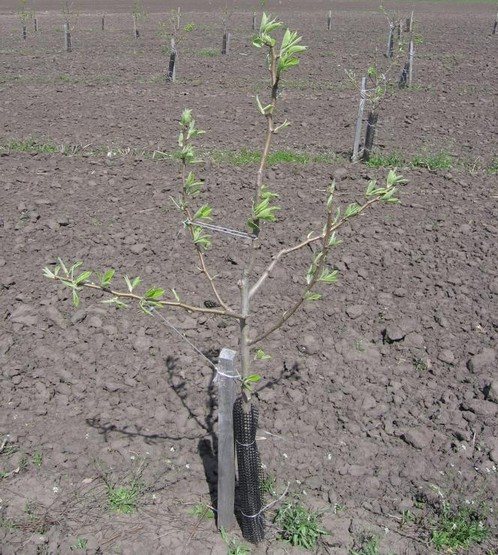

Caring for a pear is similar to caring for an apple tree. At the beginning of the season, as soon as the snow has melted, fertilizing is carried out with nitrogen-containing fertilizers, such as urea or ammonium nitrate. The second top dressing is applied, focusing on the state of the pear, if required, reapply the nitrogen or complex composition. Phosphorus-potassium fertilizers are used in the fall. Fertilizers are applied along the perimeter of crown growth. The tree is also responsive to spraying with mineral formulations. When using any dressings, it should be remembered that their excess can also negatively affect the ripening of fruits.
For the best fruiting, the pear requires pruning of dry branches, shortening by a quarter of the shoots. After the first pruning, the central trunk should be 40 cm higher than the adjacent branches. The sections must be processed by painting them with paint or garden varnish.
It is recommended to mulch the area around the trunk circle with humus, mowed grass.
On a note. To protect the lower part of the trunk from rodents, it is whitewashed with a solution of lime.



